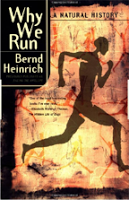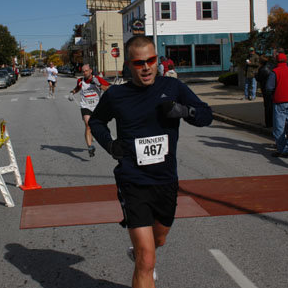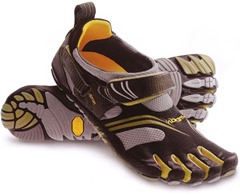Gina Kolata of the New York Times wrote an article that appeared in the paper today. The title is “Myths of Running: Forefoot, Barefoot, and Otherwise,” and the article opens with the following question:
“Is there a best way to run, so that you use the least energy and go the fastest?”
Kolata goes on to report data from studies showing that elites at the Olympic Trials land in all kinds of different ways (true), and reports on studies that show no significant difference between foot strikes in terms of efficiency (also true). I’ve got no problem with any of this.
My main issues with the article are the following:
1. It’s fine to ask if there is a best way to run from an economy and speed standpoint, but I think that it also bears mentioning that the form that let’s you run fastest may not be the form that minimizes your injury risk.
Many of us like and want to run fast, but would prioritize our health over performance in a race. Plenty of runners could care less about racing, so economy and speed matter very little. Granted, she was very open in writing the article with a focus on economy and speed, but she also writes “Proponents say barefoot running is more natural — humans evolved to run without shoes — and economical.” Maybe some barefoot proponents claim this with regard to economy, but most of the barefoot runners I know started doing it simply because they hurt less when they take their shoes off.
2. The article was overly foot-centric. Foot strike is but one aspect of gait, and my guess is that if you looked at other aspects of form you’d see a lot more similarity among the elites when compared to more recreational runners (e.g., hip extension, limb position on landing, etc.). Part of the problem with the form debate over the past few years is that it has focused way too much on the foot, ignoring other, perhaps more important aspects of gait. I am just as guilty of this as anyone else, but it’s time to take the foot off it’s EVA cushioned throne and take a broader view of form.
3. Some statements are misleading. For example, she writes that “…studies have repeatedly shown that when people try to change their natural running style, they tend to use more energy to cover the same distance.” Well, that’s because most studies that look at things like this look at short or even instantaneous form changes. They take a runner, have them run in their normal form, then ask them to force some change and make a comparison. Any new motor pattern is going to take time to learn, and until it is learned I’d fully expect it to be less efficient!
Furthermore, ignoring speed/economy, multiple studies have shown that gait retraining can provide benefits in terms of reducing limb loading, reducing pain, and in some cases can resolve long-term injuries – it may not make you more efficient, but in some cases changing form is the only way people have be able to keep running. Any running at all is going to be faster than sitting on the couch.
Regarding Rodger Kram’s barefoot/shod study (which I wrote about here), Kolata says:
“In a study published this year, Dr. Kram and his students found that runners who wore very lightweight shoes were more efficient than those who ran barefoot. (The barefoot runners wore weights on their feet to mimic the weight of the shoes, so that this would not be a factor in the results.)”
The important point here is that the study actually showed that running fully barefoot was not significantly different in terms of economy from running in a lightweight shoe. It was only when weights equivalent to the weight of the shoe were added that “barefoot” became less economical.
Kram’s second study confirmed this again, finding that “metabolic power requirements for running barefoot and in lightweight running shoes were not significantly different” on a rigid treadmill surface. Adding 10mm of foam to the treadmill belt did significantly improve economy in barefoot runners, but increasing cushioning to 20mm did not. The point is that running barefoot on a moderately cushioned surface is more economical than running barefoot on a rigid surface, but running barefoot is equally economical compared to running in a lightweight shoe (it’s probably simply the case that there are differences in how the muscles divvy up the work in the two conditions). Based on these results, they state that “it appears that the positive effects of shoe cushioning counteract the negative effects of added mass, resulting in a metabolic cost for shod running approximately equal to that of barefoot running.” For some people it might be better, for others it might be worse, and the differences wash out in a non-significant difference between the two conditions.
So, to make a long story short, all of the studies that Kolata writes about basically say that there’s little difference between foot strikes and shod/barefoot when it comes to speed and economy. I guess the “myths” would then be that one foot strike or footwear condition is better than another. At an individual level this basically means “do what feels best to you and enjoy it!”



















Hear Hear on the injury front. I switched to minimalist (can’t imagine actually running barefoot but wear VFFs) three seasons ago to outsmart chronic back problems. traditional running shoes didn’t cut it. Two other people I know switched (very low mileage runners) and found that their nagging knee pain disappeared so that they could continue running (very low mileage). Yeah, whatever works, but minimalist is definitely worth a try.
I agree that this article completely misses the point about the minimalist shoe and running form debate. Which is running with fewer injuries rather than speed. I also agree that there is too much emphasis on foot strike versus overall gait. I guess it’s easier for researchers to take high speed photos of shoes touching the ground and measure oxygen consumption than it is to do a decent study of long term injury rates versus running form.
If a college track coach was hired to improve the way a losing team could run better and then focused solely on foot strike and foot wear, he/she would be fired before the end of the season.
This article, as so many other articles, blogs posts and commentary I’ve seen over the years, suffers from logically sloppy thinking: providing evidence for or against a statement without ever clearly and explicitly (in excruciating detail) the context of that statement. E.g., “a better way to run” for whom?, for what purpose?, under what specific preexisting and current environmental and personal conditions?, etc.
What makes this worse is that it’s in the New York Times.